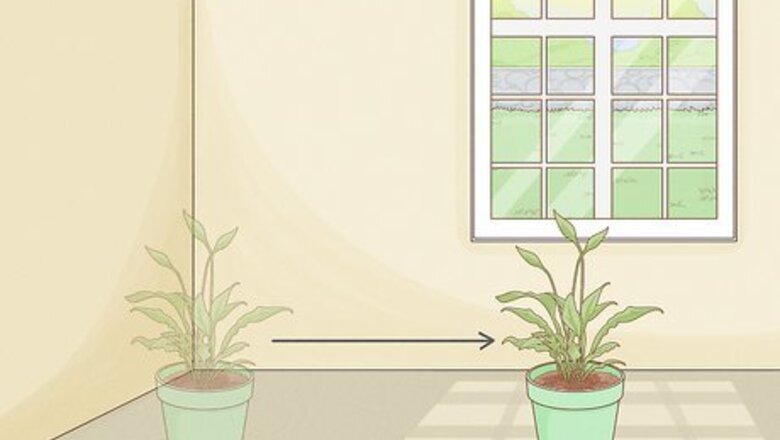
views
Caring for Houseplants

Give your plants plenty of light. One of the primary concerns for house plants is making sure they get enough light. Keeping your plants on a side-table in your living room may look good, but if it is too far from a window, your plant may not last long. Look up the sun requirements for your specific plant, and move them to a location that matches those requirements. Keep in mind that windows facing the south side of your house will receive the most light, while windows facing the north side will receive the least amount of light. Basic sunshine guidelines are as follows: Plants that need 'full sunlight' should be placed somewhere that gets 4-6 hours of direct light per day. Plants that need 'partial sunlight' should be placed somewhere that gets 2-3 hours of direct light per day. Plants that need 'shade' should be placed somewhere that gets 1 hour of direct sunlight per day.
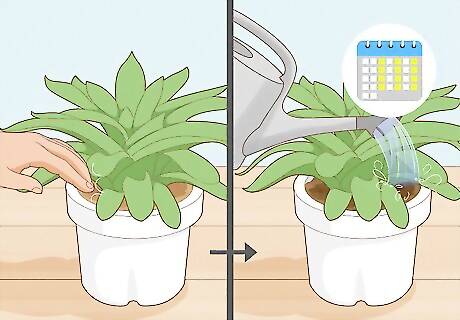
Water your plants regularly. Getting the proper balance of water for houseplants can be tricky: too much water, and the roots will start to rot because of poor drainage, and too little water and they'll dry out. The specific amounts of water needed will vary from plant to plant, as some like to be very wet all the time while others (like cacti and succulents) only need watering once every few weeks. However, most plants will thrive when watered 2-3 times a week. Use a spray bottle or small watering can, and add enough water each time so that the soil is moist without being muddy. Stick your finger in the soil up to your 2nd knuckle to see how wet it is; if your finger comes back dry, you need to water your plant. If it is wet at all, then hold off on watering for a day or two more. Always use warm water for your plants, as cold water can shock the roots and cause damage to the plant. Give your plants a deep watering about once a month. Place them in the sink and let the water run through them. This will help keep salts from building up on the surface of the soil.
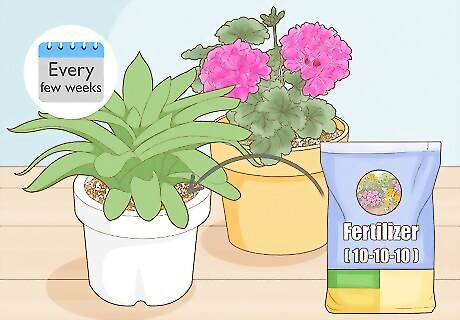
Fertilize your plants every few weeks. Fertilizer is a soil additive that supplies plants with nutrients. It is particularly important to fertilize indoor plants every 2-3 weeks, because there is no organic matter being added to the soil naturally like there would be outdoors. Most fertilizers come with a 3-number series, such as 10-20-10; these numbers refer to the amounts of nitrogen, phosphorus, and potassium the fertilizer contains. Because every kind of plant requires different amounts of those three minerals, the type of fertilizer you need to use will vary. However, starting with a 'middle ground' fertilizer such as a 6-12-6 or 10-10-10 mix should be good enough for most plants. Spray or sprinkle the fertilizer directly onto the top of the soil, according to the package directions. Liquid fertilizers can be mixed with water in your watering can. To apply, simply water your plants. You don't need to mix the fertilizer into the potted soil, as it will dissolve and incorporate into the mixture on its own over time.
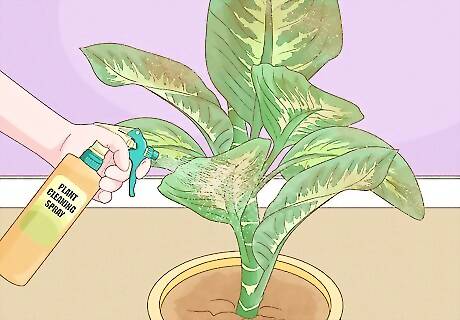
Clean dust off your plants. Indoor plants will become coated in a thin layer of dust over time. This dust takes away from the plants' natural beauty, and it also makes it harder for them to grow by clogging the 'pores' on the leaves. As a result, it is important to clean off any dust you notice on a regular basis. Depending on the size of your plant, there are two different general cleaning methods: wipe them off with a cloth, or rinse them in the sink under running water. If you choose to wipe down your plants, mix a small amount of warm water with a bit of dish soap or plant soap, and dip a clean rag into the mixture before carefully wiping down the leaves. If you run them under water, just turn on warm water in your sink and carefully rinse each leaf with your hands or a clean dish rag. Rinsing down your plant under running water works best for smaller plants. Make sure not to get too much water into the pot itself, though. There are brands of plant cleaning spray on the market that you can use to spray the dust off your plants.
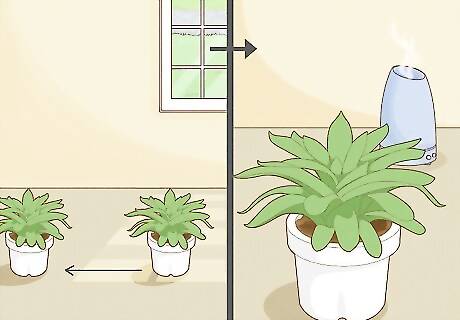
Move your plant away from air vents. Moisture levels inside of houses tends to be lower than moisture levels outside of houses. As a result, it is common for houseplants to become dried up due to a lack of humidity. Although regular watering can help prevent this, a bigger issue causing this is placing your indoor plants near air vents. Whether the heater or the air conditioner is the one working, the constant air flow will dry out the leaves of the plants and cause them to die off. To solve this problem, move them away from any vents in the room. You can also incorporate a humidifier into your décor nearby to add moisture to the air.
Caring for Outdoor Plants
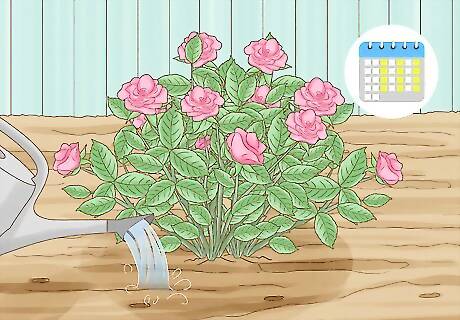
Make sure your plants are getting enough water. Caring for plants in a garden relies heavily on the natural elements and environment in proximity. As a result, the amount of watering you need to do is dependent on what the weather and soil is like in your area. It's generally a good rule of thumb to water your plants 2-3 times a week either by hand with a watering can, or with a sprinkler system. The soil of your garden should be damp without being soggy, and not so dry that it is crumbly and dusty. Check the ideal watering amounts for each plant, as some varieties prefer lots of water while others require very little.
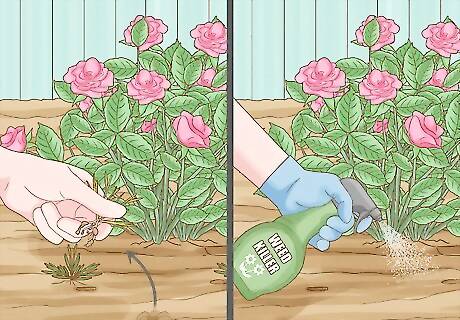
Weed your garden regularly. Weeds can spring up overnight and ruin a perfectly lovely garden. Weeds aren't only an eyesore, they also take up valuable growing space and use nutrients in the soil that could otherwise go towards growing your garden. As a result, you should try to pull weeds whenever you see them pop up. Grasp each weed as close to the ground as you're able, and then pull it straight up. doing this will increase the likelihood of pulling out the root system and slowing the growth of future weeds. You can use weed killers in your garden, but most aren't plant-specific and will kill all surrounding plants (not just the weeds). Check for weeds growing underneath the canopy of a plant or bush.
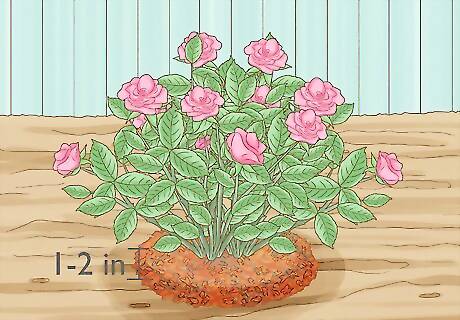
Mulch your garden every few months. Mulch is a type of organic compost that is added to the top of your garden soil to prevent weeds from growing and to trap moisture. Mulching will also add nutrients to the soil as it mixes in over time, helping your plants to grow even larger. You can purchase mulch at most garden supply stores. Simply add a layer of mulch 1–2 inches (2.5–5.1 cm) thick over the entirety of the topsoil in your garden. Be careful not to cover up the base of your plants with mulch, as this will inhibit their growth. This is especially important for small trees and bushes. You can add a layer of organic compost as a substitute for garden mulch, if you want. Keep in mind that compost will not prevent weeds like mulch will, although it is beneficial to your plant's growth. For permanent plantings, you can lay down landscape fabric over the soil to act as a weed barrier. Using this in combination with mulch will reduce weeds to almost nothing.
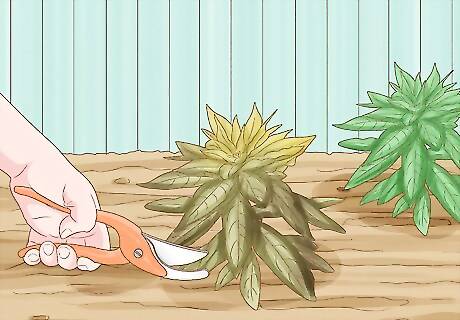
Cut off any dead or diseased plants. Plant disease can spread quickly through a garden, if not contained. The same is true for a plant that is injured; if you don't remove the dying limbs, it can continue to spread to the rest of the plant. Whenever you notice plants that are browning, dry, brittle, or otherwise sickly looking, use a pair of gardening shears to cut off the branches from the base. Throw these branches away rather than leaving them in your garden as compost, because if they do contain a plant disease, it can still spread to nearby plants.
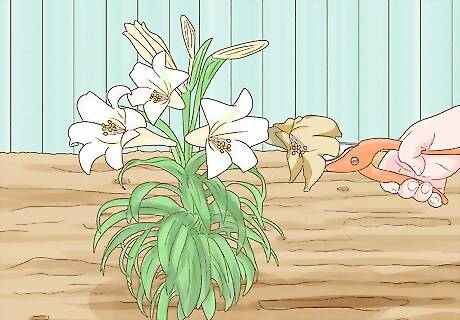
Deadhead your flowers. The term 'deadhead' refers to the practice of cutting off the dead flower heads on a plant. This will stimulate new growth, and remove the brown and dying flower. To do this, simply use a pair of gardening shears to snip the flower just below the bud. Over the next few days, you should notice a new bud begin to form and bloom. To encourage the growth of leaves, cut flower buds before they bloom. This will conserve the plant's energy. This applies to most types of flowering plants, like marigold, celosia and zinnia.
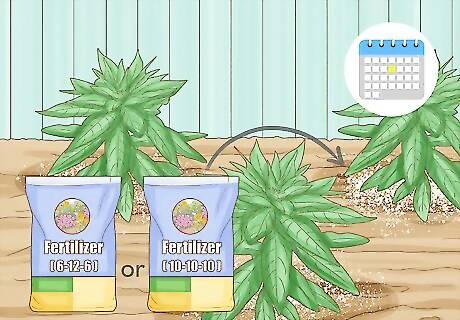
Fertilize your plants once a month. Outdoor plants get more nutrients from their surrounding environment than do indoor plants, meaning that they need to be fertilized much less. Find a fertilizer that meets your plants specific mineral requirements, or choose an 'average' fertilizer such as a 6-12-6 or 10-10-10 mixture from your local nursery. Spray or sprinkle the fertilizer onto the plants once every 4-5 weeks, according to package directions. Mix the fertilizer into the top few inches of soil. This can help reduce harmful runoff of fertilizers into waterways and other areas. If fertilizer is left on top of the soil, the nutrients will enter the air instead of the soil. Consider organic options for fertilizing. Most nutrition contained in chemical fertilizers is wasted because it is released faster than plants can use it. Furthermore, they only provide three nutrients. Mature organic compost or organic mixes provide more micronutrients. Organic compost will release these nutrients over a long period as plants need them. If you're unsure as to what fertilizer to use, ask your local nursery worker for help.
Fixing Common Mistakes
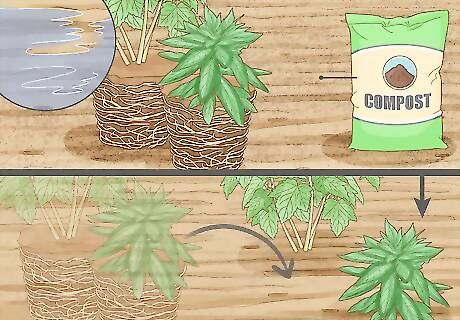
Add drainage to poorly draining soil. If your garden patch or potted plant constantly has a pool of water sitting on top, then the soil is poorly draining. This is bad, because the buildup of water can cause the roots of the plant to rot, killing the plant over time. To remedy this, carefully dig out the plant and a clump of the surrounding soil; place the plant on a tarp or in another clean pot. Mix compost or peat into the soil. Replace your plant in its original location. If all of your soil is poorly draining, you can dig it up and mix in sand to help increase the drainage.
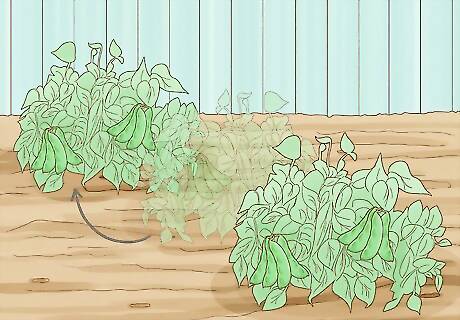
Move plants that are placed too closely together. If you got a bit over-enthusiastic and planted several plants near each other when they were small, you may have been surprised when they grew up and began competing for space in your garden or indoor pot. Plants that are put too close together will not grow as large, since there are not enough nutrients to be shared between them. Simply dig up the offending plants, and relocate them to a new garden plot or pot that has more room. Fill in the empty space with fresh gardening soil. Always use store-bought gardening soil rather than soil from your yard, as the soil from your yard contains insects, plant diseases, and weeds that will spread to your plant in its new location. You can tell that plants are too close if they are growing into each other, or if their primary stems/branches become tangled.
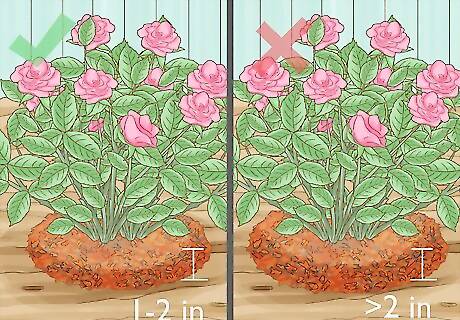
Avoid adding too much mulch. While mulching is beneficial for adding nutrients and blocking out weeds, adding too much mulch can be problematic for a garden. This is because the mulch will not only block out weeds, but will also prevent new growth from your plants from breaking the surface. Never add more than a 2-inch thick layer of mulch to your garden. If your garden isn't growing after you've mulched, take off 1–2 inches (2.5–5.1 cm) of mulch and wait a few weeks for improvement. If you add mulch too high on the base of a stem or tree, it will cut off valuable sunlight and prevent growth. Move mulch off the base of the stems and tree trunks in your garden.
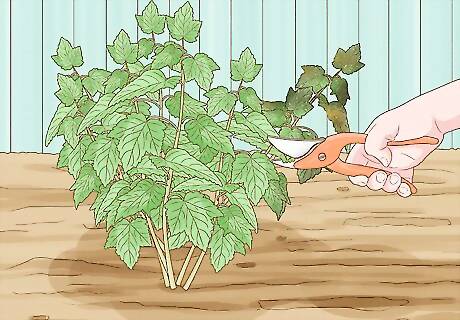
Cut off any dead or diseased plants. Plant disease can spread quickly through a garden, if not contained. The same is true for a plant that is injured; if you don't remove the dying limbs, it can continue to spread to the rest of the plant. Whenever you notice plants that are yellow, browning, dry, brittle, or otherwise sickly looking, use a pair of gardening shears to cut off the branches from the base. Throw these branches away rather than leaving them in your garden as compost, because if they do contain a plant disease, it can still spread to nearby plants.
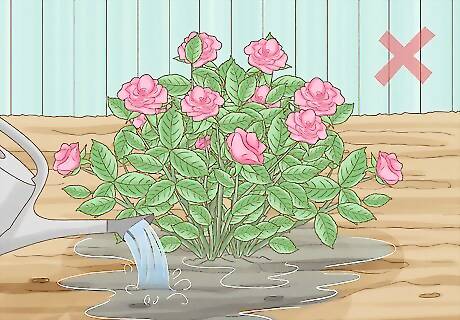
Avoid over-watering your plants. Although you may think you're watering your plants correctly, if they begin to turn yellow and droop, you're probably giving them too much water. Most plant's don't need to be watered daily, in fact they do better when given a lot of water every few days. Only water your plants when the soil is dry at least 2-inches deep. If you water every time the top of the soil looks dry, you are almost guaranteed to over-water your plant. If you are having difficulty giving too much water to indoor plants, try switching to a spray bottle for watering your plants, rather than using a watering can. Spray bottles make it much harder to add too much water, since very little is released at one time.
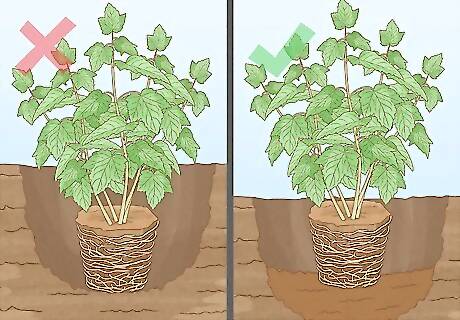
Make sure you don't plant your plants too deeply. If your plants are slowly dying and wilting for no known reason, you may have buried them too deeply. The roots of the plant need to be relatively close to the surface, so that they can extract all the nutrients from the topsoil and have access to the sun. Carefully dig up your plants, and replant them so that the root ball is just-at or just-below the surface of the soil. If the root ball is partially exposed, spread a thin layer of mulch over the top to protect it. When transplanting a plant from a pot to the garden, keep the soil level at the same depth that it was in the original pot. If your roots are mostly above the surface, your plant will die as well. You want the roots to be level with the garden topsoil.



















Comments
0 comment